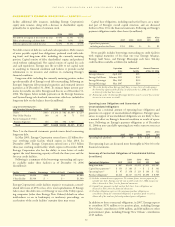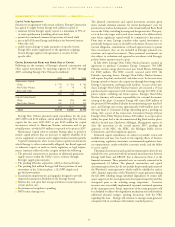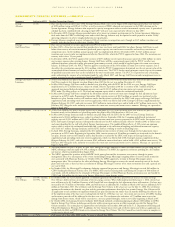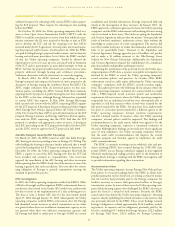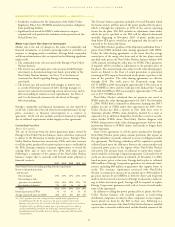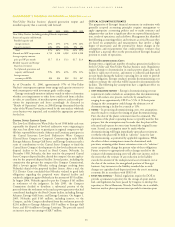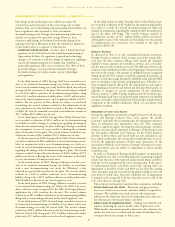Entergy 2006 Annual Report Download - page 58
Download and view the complete annual report
Please find page 58 of the 2006 Entergy annual report below. You can navigate through the pages in the report by either clicking on the pages listed below, or by using the keyword search tool below to find specific information within the annual report.
ENTERGY CORPORATION AND SUBSIDIARIES 2
2000066
42
and $23.2 million for Entergy Mississippi. $56.4 million of this amount
has been refunded to date, including approximately $22.3 million for
Entergy Arkansas, $3.3 million for Entergy Gulf States, $21.9 million
for Entergy Louisiana, and $8.9 million for Entergy Mississippi.
The FERC has also recently denied rehearing of an order that
directed Entergy Mississippi to refund to SMEPA the expense it
incurred in constructing certain facilities necessary for the intercon-
nection of its Silver Creek generating unit to Entergy’ transmission
system. Although Entergy Mississippi does not yet know the total
expense and tax obligation associated with these SMEPA facilities,
such amount is estimated at approximately $10 million.
The FERC has also recently issued an order granting one of the
complaints that have been pending before the FERC concerning
other GenCos’ requests that they receive refunds for certain facilities
necessary for their interconnections with the Utility operating compa-
nies. The order requires Entergy Gulf States to refund approximately
$5.4 million to the GenCo. This refund, along with those referenced
above, has been and will continue to be primarily provided in the
form of credits against transmission charges over time as the GenCos
take transmission service from Entergy.
The Utility operating companies (except Entergy New Orleans)
continue to be subject to several pending, but not acted upon, com-
plaints where GenCos are seeking additional refunds from the Utility
operating companies. While these matters concern the same issues
addressed by the FERC in the cases described above, the FERC has
not yet acted in these dockets, in which approximately $49.4 million
in expenses previously paid by the GenCos is in dispute, including
$26.8 million for Entergy Arkansas, $6.2 million for Entergy Gulf
States, $8.0 million for Entergy Louisiana, and $8.4 million for
Entergy Mississippi.
To the extent the Utility operating companies have been ordered to
provide refunds, or may in the future be ordered to provide addition-
al refunds, the majority of these costs will qualify for inclusion in the
Utility operating companies’ rates. The recovery of these costs is not
automatic, however, especially at the retail level, where the majority of
the cost recovery would occur. With respect to the facilities for which
FERC has ordered refunds, the Utility operating companies intend to
request the ICT to evaluate the classification of facilities that have
produced the refunds. Any reclassification by the ICT could reduce
the amount of refunds not yet credited against transmission charges.
Market-based Rate Authority
On May 5, 2005, the FERC instituted a proceeding under Section
206 of the FPA to investigate whether Entergy satisfies the FERC’s
transmission market power and affiliate abuse/reciprocal dealing stan-
dards for the granting of market-based rate authority, and established
a refund effective date pursuant to the provisions of Section 206, for
purposes of the additional issues set for hearing. However, the FERC
decided to hold that investigation in abeyance pending the outcomes
of the ICT proceeding and Entergy’s affiliate purchased power agree-
ments proceeding. On June 6, 2005, Entergy sought rehearing of the
May 5 Order and that request for rehearing is pending.
On July 22, 2005, Entergy notified the FERC that it was withdraw-
ing its request for market-based rate authority for sales within its control
area. Instead, the Utility operating companies and their
affiliates will transact at cost-based rates for wholesale sales within the
Entergy control area. On November 1, 2005, Entergy submitted
proposed cost-based rates for both the Utility operating companies
and Entergy’s non-regulated entities that sell at wholesale within the
Entergy control area. The Utility operating companies’ cost-based rates
were accepted for filing by the FERC, however, the non-regulated
entities’ cost-based rate filing was set for hearing and settlement
procedures. A settlement in principle has been reached between the
non-regulated entities and the FERC Staff concerning this issue.
Separately, the FERC accepted for filing Entergy Gulf States’
proposed cost-based rates for wholesale sales to three separate munic-
ipalities. Additionally, Entergy reserves its right to request
market-based rate authority for sales within its control area in the
future. The relinquishment of market-based rates for sales within the
Entergy control area is not expected to have a material effect on the
financial results of Entergy.
ENERGY POLICY ACT OF 2005
The Energy Policy Act of 2005 became law in August 2005. The
legislation contains electricity provisions that, among other things:
■Repealed PUHCA 1935, through enactment of PUHCA 2005,
effective February 8, 2006; PUHCA 2005 and/or related
amendments to Section 203(a) of the Federal Power Act
(a) remove various limitations on Entergy Corporation as a
registered holding company under PUHCA 1935; (b) require
the maintenance and retention of books and records by certain
holding company system companies for inspection by the FERC
and state commissions, as appropriate; and (c) effectively leave to
the jurisdiction of the FERC (or state or local regulatory bodies,
as appropriate) (i) the issuance by an electric utility of securities;
(ii) (A) the disposition of jurisdictional FERC electric facilities by
an electric utility; (B) the acquisition by an electric utility of
securities of an electric utility; (C) the acquisition by an electric
utility of electric generating facilities (in each of the cases in (A),
(B) and (C) only in transactions in excess of $10 million); (iv)
electric public utility mergers; and (v) the acquisition by an
electric public utility holding company of securities of an electric
public utility company or its holding company in excess of $10
million or the merger of electric public utility holding company
systems. PUHCA 2005 and the related FERC rule-making also
provide a savings provision which permits continued reliance on
certain PUHCA 1935 rules and orders after the repeal of
PUHCA 1935.
■Codifies the concept of participant funding or cost causation, a
form of cost allocation for transmission interconnections and
upgrades, and allows the FERC to apply participant funding in all
regions of the country. Participant funding helps ensure that a
utility’s native load customers only bear the costs that are
necessary to provide reliable transmission service to them and not
bear costs imposed by generators (the participants) who seek to
deliver power to other regions.
■Provides financing benefits, including loan guarantees and
production tax credits, for new nuclear plant construction, and
reauthorizes the Price-Anderson Act, the law that provides an
umbrella of insurance protection for the payment of public liability
claims in the event of a major nuclear power plant incident.
■Revises current tax law treatment of nuclear decommissioning
trust funds by allowing regulated and non-regulated taxpayers to
make deductible contributions to fund the entire amount of
estimated future decommissioning costs.
■Provides a more rapid tax depreciation schedule for transmission
assets to encourage investment.
■Creates mandatory electricity reliability guidelines with enforceable
penalties to help ensure that the nation’s power transmission grid is
kept in good repair and that disruptions in the electricity system are
minimized. Entergy already voluntarily complies with National
Electricity Reliability Council standards, which are similar to the
guidelines mandated by the Energy Policy Act of 2005.
MANAGEMENT’S FINANCIAL DISCUSSION and ANALYSIS continued


